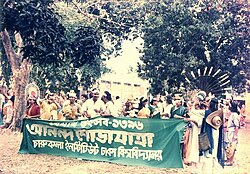Mangal Shobhajatra
Mass procession that takes place at dawn on the first day of the Bengali New Year in Bangladesh From Wikipedia, the free encyclopedia
Mangal Shobhajatra or Mongol Shovajatra (Bengali: মঙ্গল শোভাযাত্রা) is a mass procession that takes place at dawn on the first day of the Bengali New Year in Bangladesh.[1] The procession is organised by the teachers and students of the Faculty of Fine Arts of the University of Dhaka.[2] The festival is considered an expression of the secular identity of the Bangladeshi people and as a way to promote unity.[3] It was declared an intangible cultural heritage by UNESCO in 2016,[4] categorised on the representative list as a heritage of humanity.[5][6]
| Mongol Shovajatra মঙ্গল শোভাযাত্রা | |
|---|---|
 First Ananda (Later renamed as Mongol) Shobhajatra (1989) | |
| Status | Active |
| Genre | Procession |
| Date(s) | 14 April (First day of Bengali calendar) |
| Frequency | Annually |
| Location(s) | Dhaka University campus |
| Coordinates | 23.733242°N 90.3909218°E |
| Country | Bangladesh |
| Years active | 1989 – present |
| Organised by | University of Dhaka, Faculty of Fine Arts |
| Mongol Shobhajatra on Pahela Baishakh | |
|---|---|
| Country | Bangladesh |
| Reference | 01091 |
| Region | Asia and the Pacific |
| Inscription history | |
| Inscription | 2016 (11th session) |
| List | Representative |
Etymology
The Bengali phrase Mangal Shobhajatra literally means "procession for well-being".[7]
History

The procession of the festival was first observed in 1989,[8] when the autocratic ruler Hussain Muhammad Ershad was the president of the country. He became the president of the country through a bloodless coup d'état.[9]
At that time, the country was under a military dictatorship and was suffering from floods. A mass uprising took place in Dhaka during which many people, including Noor Hossain, died.[10][11] The students of the Dhaka University Faculty of Fine Arts decided to demonstrate against the regime by arranging the Mangal Shobhajatra on Pahela Baishakh.[12][13][14]
About
Every year, thousands of people take part in the procession that features gigantic replicas of birds, fish, animals, folk tale and other motifs. The rally symbolizes unity, peace, and the driving away of evil to allow progress of country and humanity.[6][5] It is considered as an expression of the secular identity of all the Bangladeshi people, uniting the country irrespective of class, age, religious faith, ethnicity or gender.[3]
UNESCO recognition
In 2014 the Bangla Academy compiled a nomination file that was approved by the Ministry of Cultural Affairs of Bangladesh and submitted to UNESCO.[12] On 30 November 2016 the Mangal Shobhajatra festival was selected as an intangible cultural heritage by the Inter-governmental Committee on Safeguarding Intangible Cultural Heritage of UNESCO at its 11th session, which was held in Addis Ababa, Ethiopia.[14][12]
Celebrations in India
In 2017, following the footsteps of Bangladesh, the festive Mangal Shobhajatra was brought out in West Bengal.[15][16]
References
External links
Wikiwand - on
Seamless Wikipedia browsing. On steroids.
